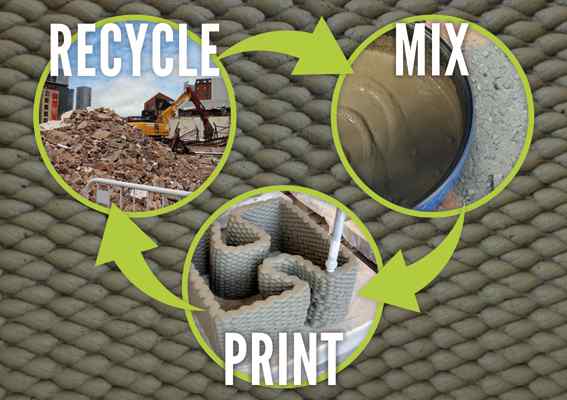Images of climate innovation
A circular economy approach to 3D Printing Cement
Manchester Metropolitan University's PrintCity is developing a mortar for use in 3D printing using locally sourced demolition waste as a substitute for sand. Worldwide, we use 50 billion tonnes of sand every year; the energy required to extract it, and the damage caused to the environment, is substantial. Finding alternatives to this ever-increasing demand is vital to supporting the adoption of a circular economy.

Additive Manufacturing (AM) is the process of turning a digitised 3D model in to a physical object by adding layer upon layer of material an additive process. Traditionally cement objects are formed by casting, a process that requires a mould that takes time to manufacture and is costly for small-scale production jobs. AM gives the freedom to produce complex, customisable geometries in a fast and economical manner that is available locally, removing the need for moulds, transport, and storage of large inventories. In NW Europe 65 million tonnes of fine aggregate are generated yearly from demolition wastes and are down-cycled either being disposed of in landfills or used as backfill.
This waste cannot be recycled back into concrete due to impurities and the need to meet rigorous construction standards. Funded by Interreg NWE, CIRMAP has 13 partners from 5 countries who will develop mortars using locally sourced demolition waste and will develop designs for the production of customised shapes using AM.
CIRMAP will design Urban, Memorial and Garden (UMG) furniture for local authorities and will showcase five objects in each of the five partner countries. UMG furniture is often located in difficult-to-access areas, AM can reduce the weight of an object by shape optimization and allows for fabrication onsite, making the whole process easier. This method lends itself to many industries, not just UMG furniture, in fact, AM is influencing global sectors from the medical to aerospace industries, from boats to clothing and buildings to food.
Entrant: Sheryl Lee , Manchester Metropolitan University
Copyright: Nick Hurst and Sheryl Lee (Manchester Metropolitan University); Hyperion Robotics
Collaborators: ARMINES; Technical University of Kaiserslautern; Neo Eco Development; University of Liege; University of Orleans; Heberger GmbH; VICAT; Gemeente Almere; Stadt Pirmasens; University of Lille; CERIB; AREBS; CTP; ENSAPL; CNRS.